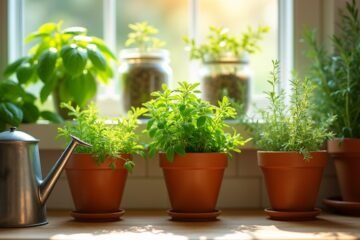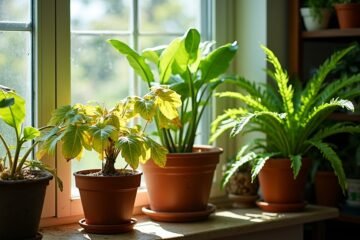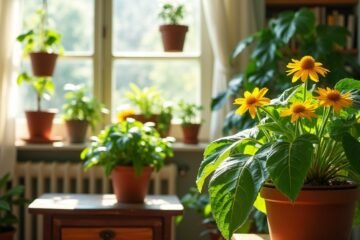To keep your indoor garden vibrant, avoid three big mistakes! First, don’t overwater your plants; soggy soil leads to sad, wilting leaves. Remember, plants prefer a little thirst! Second, ignore their light needs at your peril—every plant has its favorite light wavelength, so check which way the sun shines! Finally, don’t skimp on soil; the right mix can make your plants thrive like they’re at a fancy spa! Curious for more tips? Stay tuned!
Overwatering Your Plants
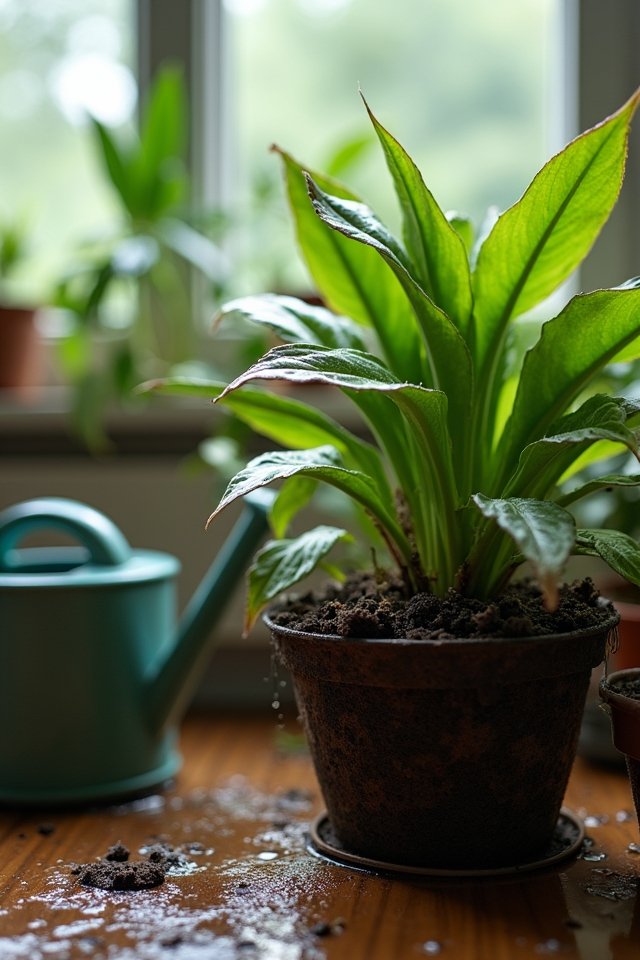
If you’ve ever wondered why your beloved fern looks more like a sad, soggy sponge than a vibrant green plant, you might be guilty of overwatering! It’s easy to get carried away, thinking more moisture equals happier plants. But let’s face it: drowning your ferns can lead to root rot, the ultimate plant party crasher! Instead of flourishing, your plants are gasping for air, suffocating under excessive water.
To strike a balance, always check moisture levels before you splash more H2O. Stick your finger into the soil; if it feels damp an inch down, hold off! Trust me, your ferns will reward you with lush, green leaves that stand tall instead of drooping in defeat! Who knew less could truly be more?
Ignoring Light Requirements
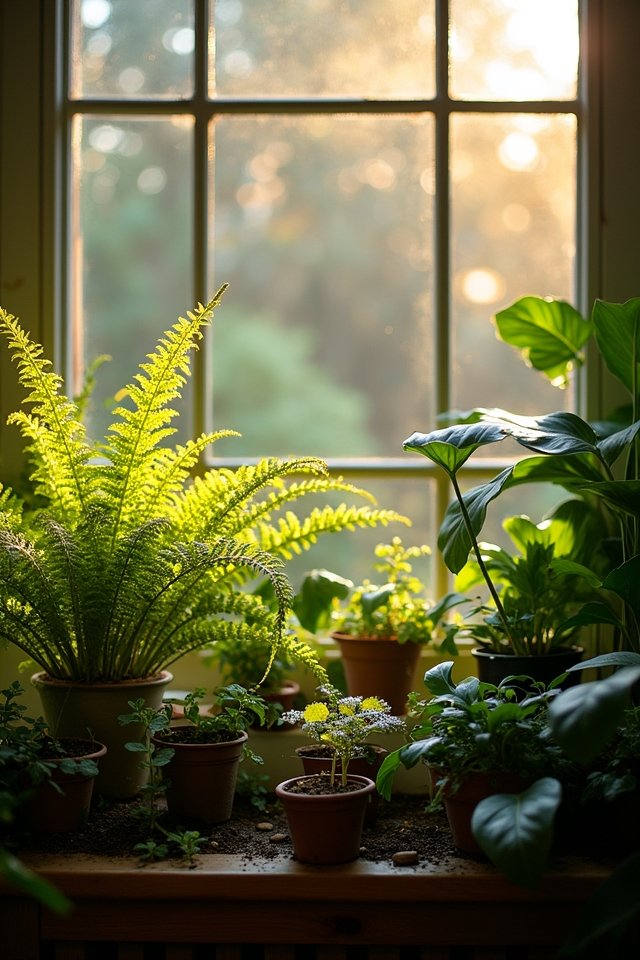
While your plants might be standing tall and proud after mastering the art of watering, there’s another slippery slope that can leave them wilted and weary: light! Ignoring your plants’ light requirements is like trying to run a race with one shoe. Let’s shine a spotlight on what you need to know:
- Natural Light: Position your plants near windows for that glorious sun-kissed goodness!
- Light Spectrum: Different plants need different wavelengths. Research what suits your greenery best—some crave more blue light, others red.
- Duration: Make sure your plants get 12-16 hours of light daily. Yes, they’re not nocturnal!
Choosing the Wrong Soil
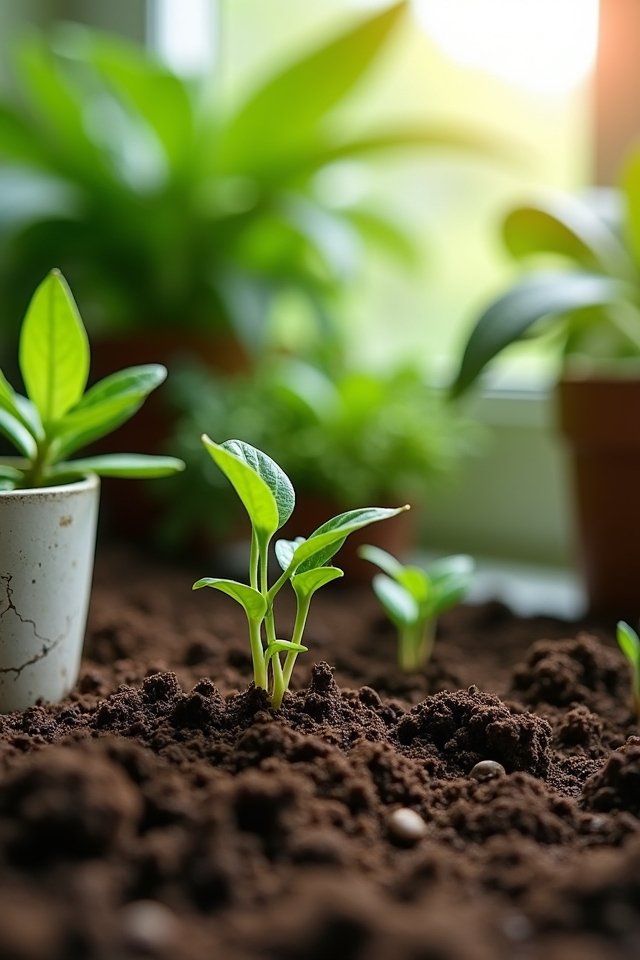
Choosing the right soil can feel like picking the perfect dance partner; one wrong move, and your plants might end up stepping on each other’s toes! You’ll want to explore diverse soil types, each with unique textures and benefits. For instance, a well-draining mix is essential for succulents, while a rich, moisture-retaining blend works wonders for tropical plants. Keeping an eye on nutrient balance is just as important; too much fertilizer can overwhelm your green friends, making them feel like they’re on a dancing spree without rhythm! Are you using potting mix instead of garden soil? That’s a big no-no! So, choose wisely, and your plants will thrive, twirling happily in their vibrant, supportive environment!
Frequently Asked Questions
How Do I Know if My Plants Are Getting Enough Humidity?
Wondering if your plants are in a rainforest or a desert? To check those humidity levels, invest in a moisture meter—your plant’s best buddy! Aim for 40-60% humidity for happiest greens. If the air feels dry and your plants droop like sad sponges, they’re craving more moisture! Mist them regularly or place a pebble tray of water nearby, and watch them perk up like they’re soaking in sun rays! Keep that humidity flowing!
Can I Use Regular Tap Water for My Indoor Plants?
You can definitely use tap water for your indoor plants, but be mindful of its quality! While most tap water’s fine, some contain chlorine or fluoride, which can be a bit harsh on delicate greenery. Think of it as giving your plants a spa day! If they seem droopy or unhappy, try letting the water sit out overnight to let the chemicals evaporate. Your plant health will thank you for it; trust me!
What Types of Fertilizers Are Best for Indoor Gardening?
You might think all fertilizers are created equal, but that’s far from the truth! For your indoor garden, organic fertilizers like compost or worm castings are fantastic—they nourish your plants naturally without chemicals. Liquid nutrients offer a quick boost, making your leafy friends thrive! Imagine feeding your plants a nutrient smoothie, giving them the energy they need. So, dig in and explore; your indoor oasis will thank you with vibrant growth!
How Often Should I Rotate My Plants for Even Growth?
You should rotate your plants every two weeks to encourage even growth patterns! Just like you, plants enjoy a little variety. They’ll stretch toward the light, so turn them to get a balanced glow. Imagine your leafy buddies basking in all that sunshine, thriving in their prime! Neglect this little detail, and you might end up with some plants looking like they took a yoga class on one side. Keep ‘em happy and rotating!
What Are Signs of Pests in Indoor Plants?
You know that feeling when something’s just not right? That’s how your plants might feel with pests lurking around! Keep an eye out for tiny holes in leaves or sticky residue—those are clear signs of uninvited guests. Yellowing leaves? It could mean you’re dealing with aphids! For effective pest identification and prevention, making regular checks part of your routine can save your green friends from dramatic transformations. Let’s keep those plants happy and thriving!
